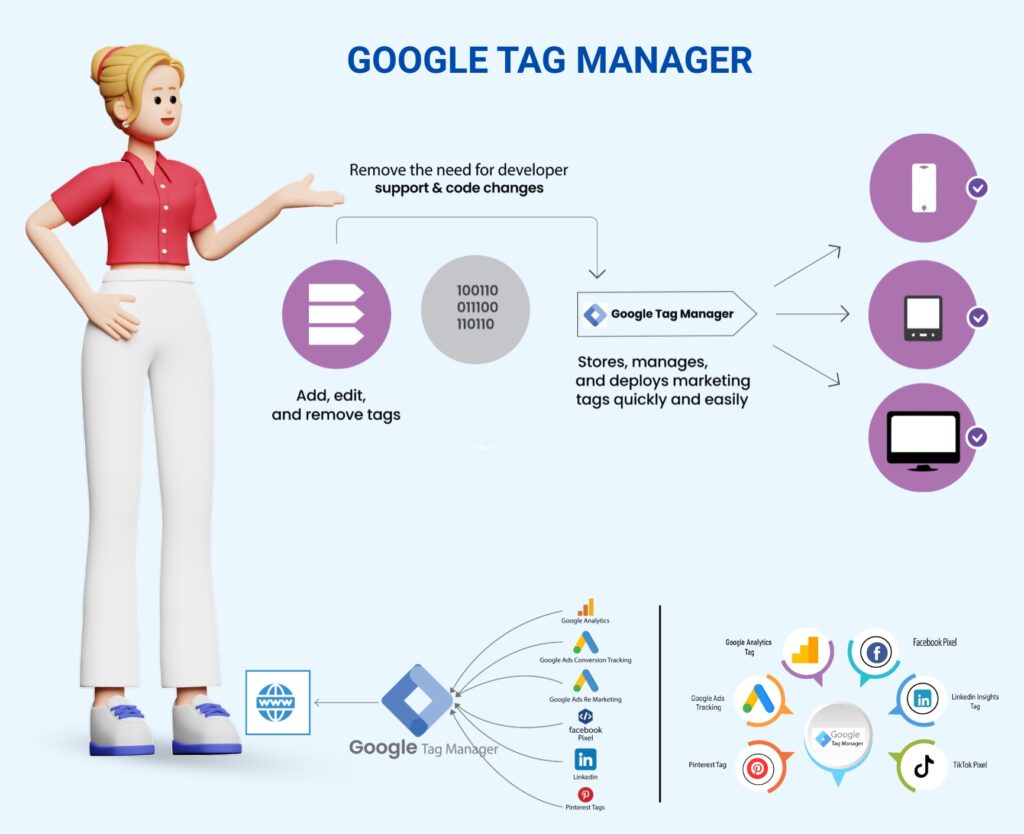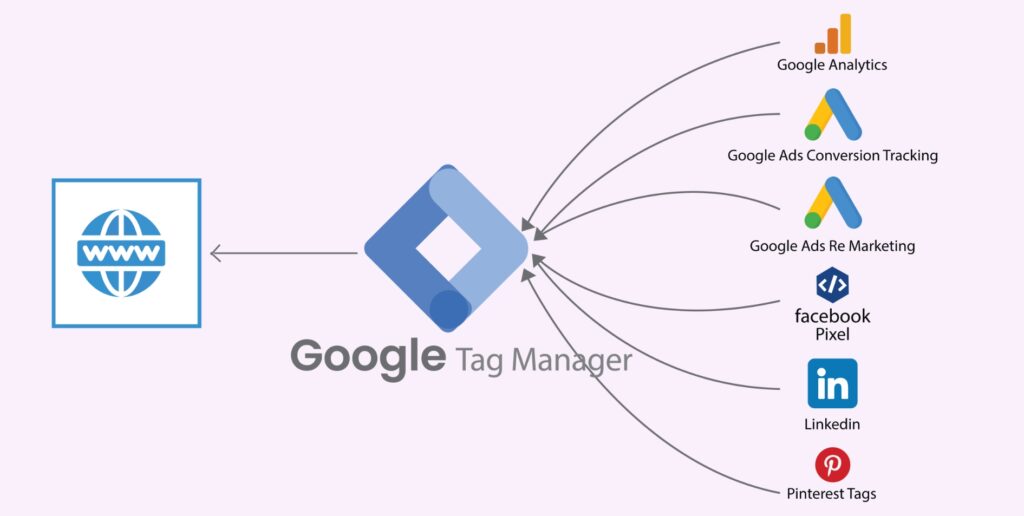
Our Services
We deal with entire Google Tag Manager (GTM) setup for easy and green tag deployment. From tag implementation with GTM to superior GTM occasion tracking, we make sure each click, form, or movement is tracked accurately, supplying you with cleanser records and higher advertising insights.
GTM setup
Expert – Be accurately persecuted with GTM setup. Configure Google Day Manager to efficiently manage all tags and manage support for time procurement, improving data accuracy, and better marketing decisions. From setup to testing, everything runs smoothly and you can focus on growing your business.

Tag implementation with GTM
Simplify tracking with Expert Day implementation using GTM. Instruct and manage all your marketing and analytics tags in Google Tag Manager to ensure clean data and faster loading times. Whether it’s Google Ads, Meta Pixels, or GA, make sure your daily fires accurately and efficiently.

GTM event tracking
Switch to deeper knowledge using GTM -Event -Tracking. It helps you perceive user actions such as clicks, form submissions, and video views in Google Tag Manager. The setup allows you to accurately record all important interactions and receive the data you need to optimize your campaigns and improve your user experience.

Google Tag Manager – A Complete Guide for Website Owners
Heard of Google Tag Manager by chance? Pretty sure most websites and marketing folks probably have. It simplifies how tags track on site; that’s what makes it quite useful. This guide explains Google Tag Manager, its function, and why businesses find it valuable.
So, what’s Google Tag Manager all about anyway?
Google Tag Manager’s free, maybe helps manage marketing tags without a code change. Basically, it helps drop in tracking stuff, maybe Google Analytics or Ads, without bugging a developer for site updates. If you’re new, a Google Tag Manager tutorial can help you get started quickly.
Marketers needed developers before GTM whenever a new tracking pixel or event adjustment came up. GTM? You can handle most tasks yourself through one dashboard; that’s time saved and fewer errors.
So why use Google Tag Manager?
Websites today use trackers to see how things work, show ads, and maybe make site better for you. Without something like GTM, tag management might get messy, wouldn’t you think? You could wind up seeing copies in code, perhaps tags forgotten, maybe tracking broken too.
So Google Tag Manager matters because tag management gets simpler; all tags live centrally. Forget endless searching through source code.
For quicker changes, if you want a new pixel or maybe an event modification, just use GTM; don’t wait on a developer.
GTM helps cut down errors which, let’s face it, often pop up from manually messing with site code.
GTM helps manage when tags fire, possibly improving site speeds, so that’s something.
Version control means each GTM tweak? It’s tracked automatically. If something doesn’t pan out just right, you’re able to roll it back.
So, how does Google Tag Manager actually work?
GTM’s container is its core, you know. Think of it as code you just drop onto your site a single time. So in GTM you’re equipped for tags and triggers and variables which manage things that kick off with your site visitors.
Tags? These are small code bits you might run, kind of like Google Analytics or maybe even Facebook Pixel.
Triggers basically define when plus where tags end up firing, right? Like say a tag fires on every page, after form submits, or maybe when folks click a button.
Think of variables as containers; they hold data that tags and triggers might need like maybe a page’s URL or text from a click.
Once it’s set up, GTM loads tags based on rules so your website’s core code needs fewer changes.
Businesses often use Google Tag Manager for a site’s Google Analytics setup to track activity.
Go ahead and set up conversion tracking inside Google Ads.
Go ahead and install Facebook Pixel or LinkedIn Insight Tag.
Track events custom to you such as clicks, downloads, or video plays — this is called Google Tag Manager event tracking.
You’d manage scripts from other companies like A/B testing or chat.
GTM keeps tracking organized and efficient since all manage in one spot.
Want Google Tag Manager setup? It’s pretty simple: Just head over its website and create an account to begin. Go ahead and make that place for your site, you know, like a container or something.
Google then provides code; put inside your website’s HTML. Just add once; you’re all set.
Set up your tags maybe? Inside GTM you can create tags for Google Analytics, ads conversions, or even custom events; true to you.
So triggers, right? Define when tags fire. Like when page loads or maybe after folks submit form.
GTM includes a preview mode; use it to check your setup before going live.
Okay so after you are satisfied, go ahead and publish changes. Okay, so your tags should run how you set them up.
To really get most from Google Tag Manager, make sure workspace is neat and orderly, name tags, triggers, variables clearly so you and your team can understand them later.
Try folders; that way navigation becomes simpler.
Test things well: Always preview within GTM before changes go live so site won’t break.
Add just tags needed so site works great.
Documenting setup? Keep notes explaining each tag, trigger, and variable. This might just help keep things shipshape when maintenance or audits roll around.
See GTM’s best benefits here — you get real control over tracking without diving into code every time.
Marketing teams can move faster deploying new tracking tags.
More precise? Less data mess and fewer slip-ups.
Better privacy law compliance happens ’cause you get a say in tags launch.
GTM won’t cost you anything — it’s free, so businesses small and large can use it.
For managing a website or campaigns, Google Tag Manager integration is a pretty good option. It makes a once slow, error-ridden job simpler, more flexible, and gives you more control. Having GTM setup? Expect faster moves, better choices, and tracking that stays clean plus reliable.
If tracking’s new or needs boost, just know GTM brings power no sweat. Learn it well; finding returns in better data, a smoother site, and marketing confidence might help.
Want a Google Tag Manager tutorial step-by-step, or maybe some SEO’d meta tags and titles helping you out? Hey, let me know.
Google Tag Manager: Simplify Tracking, Maximize Insights
Easily manage and deploy marketing tags with Google Tag Manager for faster setup, cleaner data, and smarter campaign tracking.
FAQ
What is Google Tag Manager and why should I use it?
Google Tag Manager (GTM) is a free tool that makes it easy to manage and deploy marketing and analytics tags on your website without editing code. We help you use it to streamline your tracking and improve data accuracy.
Do you provide complete GTM setup services?
Yes! The entire GTM setup, including account configuration, container creation, and tag organization, is handled by our team, ensuring the strength and scalability of your tracking foundation.
Can you help with tag implementation using GTM?
Absolutely. We offer expert tag implementation with GTM for tools like Google Ads, GA4, Meta Pixel, and more. We make sure all tags are properly placed and firing correctly.
What kind of events can you track with GTM?
In order to gain a deeper understanding of user behavior and campaign performance, we set up GTM event tracking for key user actions like clicks, form submissions, scrolls, video views, and more.

